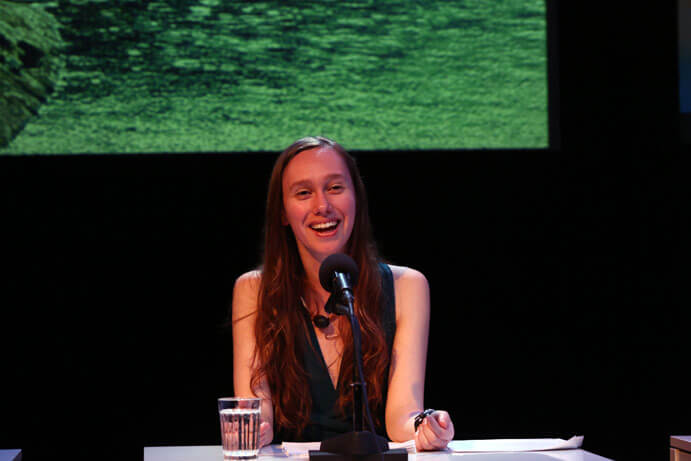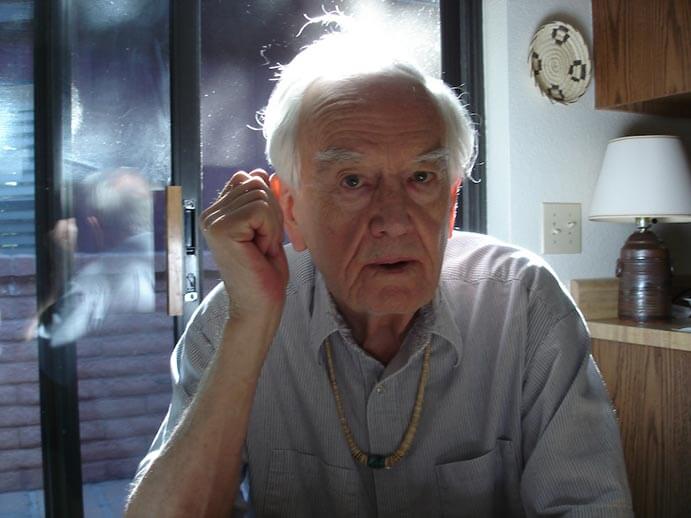Roulette will present Robert Ashley’s final opera Crash, in Brooklyn, New York, April 15-18, 2015. The cast features the Varispeed collective (Gelsey Bell, Brian McCorkle, Paul Pinto, Dave Ruder, Aliza Simons), vocalist Amirtha Kidambi, and Ashley’s longtime music director and sound engineer Tom Hamilton. We spoke with Hamilton, Ruder, and Bell about Crash and Ashley’s enduring legacy.
Robert Ashley was a relentless innovator of the entire concept of opera; what is his essential impact on the art form?
Gelsey Bell: Bob revolutionized what opera could be and infused many with a sense of a new beginning for what specifically American opera could be. He listened to the inherent musicality American English speech already contained and built his music for that. He believed that traditional Italian opera developed a musicality based on long vowels because of the Italian language, so he composed to highlight the inherent rhythms of consonants in American English. He also developed a specific vocal technique for this emphasis that encourages the listener to simultaneously experience music and words without tipping the scale toward one or the other. When first hearing Bob’s work, many people think the singers are just talking. But we are in fact talking in a very specific kind of musical way, which is ultimately singing. Just like seeing a new color for the first time, once you hear the singing of Bob’s operas, you start to hear the musicality of speech everywhere. You can’t go back.
And at 83, Ashley was still innovating; what new ground is broken in Crash?
Dave Ruder: Crash is different from Bob’s previous operas in that it is totally a cappella: just six voices, with four of them audible at a given moment. One of those is the lead voice, with a change of vocalist and narrative every 30 seconds. Each lead voice carries one of three narrative threads, with three corresponding vocal styles. “Crashes” recount times of stress when the speaker passed out. “Thoughts” are fast-paced musing on topics from the problem of neighbors to the Dead Sea Scrolls. “The Journal” is an accounting of Bob’s nearly 84 years on the planet, recounting each year in 30 seconds. Underneath the lead voice is a constant chanting from three quiet voices, summarizing the stories from “The Journal” in a kind of cubist manner. On stage, behind the vocalists, a series of photographs by Philip Makanna is projected – “vast beautiful landscapes, intended to allow the audience to hear the singing and the texts without visual distractions.” Crash doesn’t let up for 90 minutes. It’s got a range of emotions, from joy to fear to humor to hopelessness, and it beautifully depicts the realities of aging on a micro and macro level.
There’s a uniquely recognizable Ashley sound; how is that accomplished in Crash, and how can that performance practice be sustained into the future?
Tom Hamilton: Crash presented a very different challenge because Bob was not able to attend rehearsals. Plus, there is no orchestra to set the pacing – the singers do it all. But he chose these singers and named them in the score, so they are the ones to define the original sound and characters. As music director, I’ve been able to share and react based on the way Bob’s company has done things for 25 years. And as sound designer, I reinforce that by employing the techniques and effects that I developed for the earlier pieces.
The performance “textbook” is the collective memory of Bob’s ensemble. Future companies can and should have face-to-face contact with the original cast in order to continue the authentic line. All the performance materials exist for those older pieces, including the scores and electronic orchestral accompaniments. But so much that was idiosyncratic about the technique and staging was settled at the time by all involved. Most of those pieces have been released on commercial CDs performed by the original company, and much can be learned about the performance style by listening to those recordings.
Dave—what attracted you to Ashley’s work and how does your experience with it affect your own projects?
Dave Ruder: I got hooked on Bob’s music eleven years ago when I watched Perfect Lives. I was totally consumed by it. I loved the economy of the four performers. I liked the idea that a composer’s main job could be writing text and talking. It was totally novel to me, both absurd and deadly serious, existing on a different thought plane than most contemporary music. I dug deeper into his catalog and some years later met Bob at a performance of Perfect Lives. Getting to know about his music from the man himself is one of the great experiences of my life. That he wrote Crash for the six of us, that he allowed us to tell this last chapter of his work, is a huge honor and we all take the responsibility very seriously. As for my own work, I realized that my strength, via working on Bob’s music, has been investigating a kind of sung/spoken spectrum and allowing speech to move at the speed it wants to move, rather than shoe-horning it into the rhythms of notation. Bob’s style is so natural but so specific, and because he gave us so many different takes on how his brand of vocalizing could work, it’s hard for me right now to not feel derivative.

Gelsey Bell in Robert Ashley’s Crash (credit: Gelsey Bell, Courtesy of Lovely Music)
Gelsey—what drew you in and how has it influenced your work?
Gelsey Bell: I was first attracted to the grandness of Bob’s work and have found that each work I get to know becomes richer and richer with more exposure. It is like discovering a garden where different plants blossom on each visit. I have been particularly influenced by Bob’s vocal technique, which, as a classically trained singer who dabbles in many kinds of virtuosic tricks – from high notes to multiphonics, has particularly impressed upon me the power of subtlety and the creation of song that moves so fast you only catch glimpses of the melodies as they pass. I also have learned a lot from Bob’s work about collaboration and creating structures for musicians to inhabit – basically how to make music with and for your friends.



















